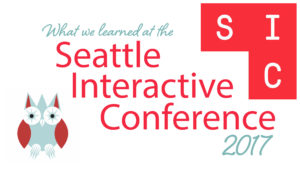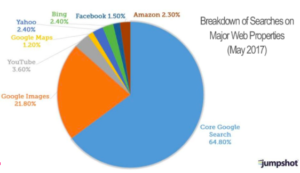14
Sesame SEO Does SIC

Each year like clockwork, Google makes significant changes to their various platforms and ranking algorithm. Every change comes as a result of consumer search habits and emerging technology that make up today’s fast-paced modern climate.
Our Sesame Search team works tirelessly to stay on top of these changes as the online community continues to evolve. This year, Sesame’s Search Team attended the Seattle Interactive conference, allowing us to make connections with cutting edge companies and business professionals from all over the globe who focus on marketing tactics in today’s online space.
Rand Fishkin, founder and former CEO of Moz, detailed how SEO is affected by Google’s changes and search behavior and he had the numbers to back it up.

Data on Search Behavior
With Beyond Core Google search dominating as the most prominent major web property, a third of all searches performed in Google are for images.In fact, 12.5% of all search result pages show image results. Photos of visually sold services or anything that is designed to acquire backlinks, are excellent opportunities for our team of SEO specialists to provide image optimization. An example of these opportunities for oral health professionals would be before and after treatment photos, photos of events in the community, or photos around the office.
Moving from Results to Answers
Interestingly enough, many search queries receive no clicks at all! Google is willing to forgo revenue in the short term in exchange for encouraging addictive search behavior. Up to 49% of all searches result in zero clicks because the query is answered by a featured snippet or an extracted, card style answer. This addiction to getting information as quickly as possible has grown so powerful that the amount of clicks Google sends out today is still more than every day before it. By providing quick answers in the form of snippets, card-style answers and photos, they are encouraging more traffic than ever before by capitalizing on the idea that, “Google knows what I mean”.
Expressed vs. Implied Intent
A few years ago, when an online user searched for something within Google, the search query terms determined the results provided. Now, it’s not so cut and dry. Google knows what you want before you do, and offers the immediate suggestions to prove it. Fishkin shared several elements Moz believes Google uses in predictive intent:
- Location & prior behavior of users in your location
- Mobile device attributes: type, O/S. speed, installed apps, etc.,
- Search, app, & browser history
- Gmail behavior
- Temporal elements & time-based patterns
For example, if someone searched for something in Seattle and a different person made the same search from a different city, they would be presented with entirely different results. However, it’s not just search results; Google uses predictive intent to affect rankings as well. Fishkin showed how searching for “storm” in Seattle provided the top results for local business and sports affiliates, but performing the same search query in San Diego provided links to local equipment manufacturers and comic book characters.
Personalized search is so much more than just search history; email behaviors, the type of smartphone you use and even time-based patterns can affect the way results are presented to you.
Top 3 Broad Areas of Google’s Ranking Algorithm
- Content- The text you provide on your website should match what Google machine intelligence systems calculate to be high quality, relevant to the topic, and match for the user’s intent. Typically, most dentists and orthodontists use the same library content for each of their common procedures. No matter how successful your practice is, rankings will plateau or take a dive when Google re-crawls their search engine and realizes that the content you have isn’t tailored specifically to your practice and physical location.
- Links- Is a competitor always outranking you? Chances are they have some powerful local links! Having other websites linking, AKA pointing, to yours is a huge way to generate more traffic and better rankings. Do you sponsor clubs, charities, or organizations? If these groups are willing to link to your website on theirs, our SEO team can link to them on your “Meet the Dr.” page where you can touch on your community involvement. The links gained are all the more powerful when the anchor text in the link contains keyword phrases that describe the nature of the page or the site gaining the links.
- Query Satisfaction- If Google sees a high bounce rate of users arriving at your site and immediately leaving (bounce rate sessions have a duration of 0 seconds), that tells them that that your page/site isn’t solving search queries, and they will likely demote you in search results.
To combat these fluctuations, creating unique content written in a conversational tone with a lot of personal detail is the most helpful when showcasing what makes your practice special.
At Sesame, your SEO specialist analyzes your data and implements local SEO strategies in an effort to get you closer to your SEO goals. However, no one knows your practice better than you! We see the most success from the practices that are willing to collaborate with us. So, don’t hesitate to reach out to the SEO team so we can guide you on how to use these tactics to differentiate your practice from your competitors!
